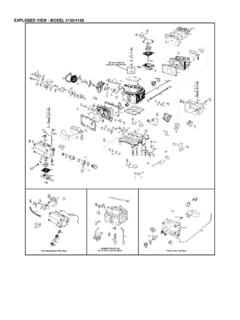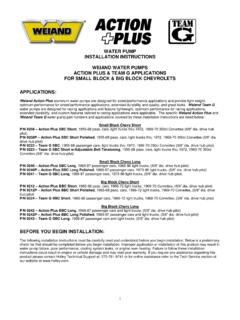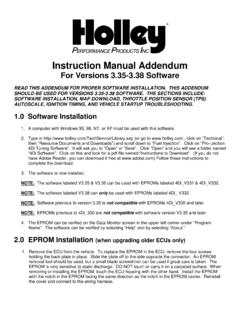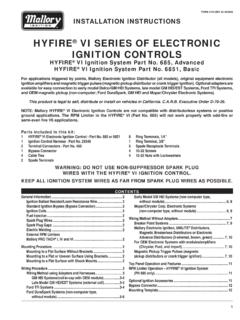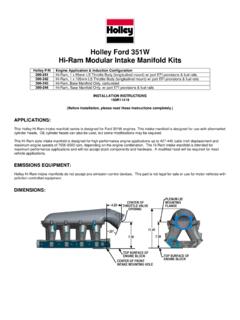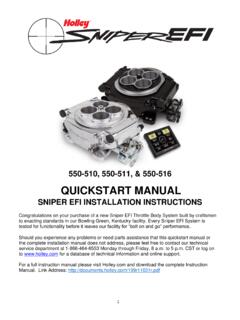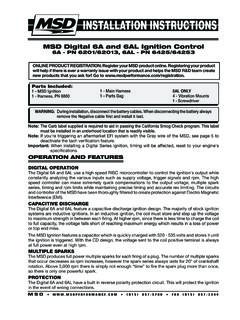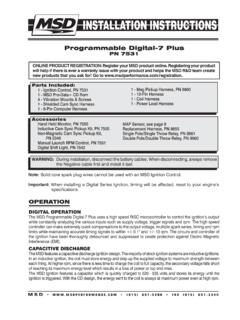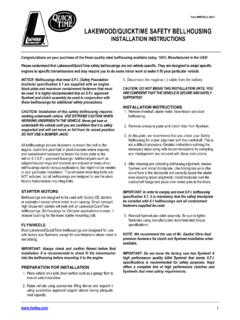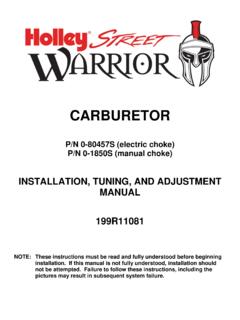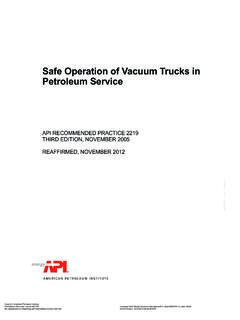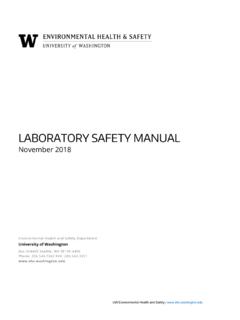Transcription of BRAWLER SERIES CARBURETORS - Holley
1 BRAWLER SERIES CARBURETORS Installation Instructions Please Stop and Read these Instructions before proceeding. If you do not fully understand the installation and tuning instructions you should seek professional help. Failure to follow the proper installation and tuning may result in damage or injury. BRAWLER would like to congratulate and thank you for purchasing this carburetor. We feel you have purchased the finest street performance carburetor currently on the market. If you need assistance, please call the BRAWLER Sales and Tech Support staff @ 270-781-9741, Monday through Friday 8AM 5PM CST.
2 The calibration should be very close for all adjustments. Different engine combinations could require adjustment of idle mixture, idle speed, and main jets. The fuel level was set with 6 lbs. of fuel pressure. The recommended fuel pressure for this carburetor is 6 PSI. NOTE: This BRAWLER carburetor has not been submitted for emission testing, therefore it is not (California Air Resources Board) legal in all 50 states - please check with local authorities regarding the use of this carburetor. REMOVE OLD CARBURETOR: 1. Disconnect negative battery terminal to prevent any accidental arcing in the presence of fuel.
3 2. Remove air cleaner, PCV hose and any other vacuum lines connected to the carburetor. For future reference identify the vacuum lines to ensure proper re-connection. 3. Remove fuel line(s). Be careful not to twist fuel line(s) when removing fuel inlet fitting(s). Use penetrating oil or similar chemical to assist in breaking the fuel inlet fitting nut loose. Protect the open ends of the fuel lines, so no foreign particles can enter. 4. Disconnect electric choke wires if equipped (identify if necessary). 5. Disconnect all linkage and return springs.
4 6. Remove the 4 hold down nuts and washers (if used). 7. Remove carburetor from intake manifold. 8. Cover intake manifold carburetor flange with a clean rag or towel to prevent any foreign objects from falling into the engine. INSTALLATION OF NEW CARBURETOR: 1. Set old carburetor and new carburetor side-by-side on work bench. 2. Examine linkage connection (throttle cable [rod] and kickdown cable [if applicable]) transfer to new carburetor in same location if possible. 3. Install flange gasket over intake manifold studs on intake manifold, then install your new carburetor.
5 Install throttle cable bracket on driver s side rear stud if applicable. 4. Install hold down nuts and washers (if used), tighten in a criss-cross pattern. DO NOT TIGHTEN HOLD DOWN NUTS COMPLETELY. 5. Attach throttle and kickdown linkage then operate from inside the vehicle to be certain there is no interference of throttle plates, throttle linkage, accelerator pump arms or fast idle cam lever. 6. If there is no interference or resistance in throttle operation then you can tighten the hold down nuts to their final torque value, 100 Inch Lbs.
6 (8 Ft. Lbs.). Most intake manifold studs are a fine thread and therefore tightening the hold down nuts must be tightened in a criss-cross pattern and in a number of steps before arriving at the final torque value. Rapidly tightening the hold down nuts to the final torque spec or over-tightening will cause performance problems as this process can warp or potentially break the throttle body. 7. Install vacuum hoses. The PCV hose is installed on the rear 3/8 tube at the rear of the throttle body. This tube can also accommodate power brake hose connection as well if PCV is either not used or is routed to a different location on the engine.
7 It is not advisable to T the PCV and power brake hose together. These two lines should be separated. If the PCV was originally attached to the carburetor it should be installed the same way on your new carburetor. The power brake hose must be attached then it should be routed to another vacuum connection in the intake manifold. This connection should be to the plenum of the intake manifold, not an individual intake runner. vacuum connections to the new carburetor as shown below: Distributor vacuum advance may also be connected to the tube in the primary metering block.
8 8. Install fuel inlet fittings DO NOT USE PTFE TAPE ON INVERTED FLARE FUEL INLET FITTINGS. Clean threads and flare of any dirt and debris before installation. Check to be certain the fuel inlet fittings in the fuel bowl are tight, then install the fuel line nuts. Tighten sufficiently to prevent fuel leakage. Manifold vacuum is typically used for transmission modular or any accessory that requires a full manifold vacuum signal, heat and/or A/C control, vacuum actuated fresh air induction, etc. The ported or timed vacuum is typically used for the vacuum advance canister on the distributor if applicable.
9 NOTE: Some distributor vacuum advance canisters require full manifold vacuum , not ported or timed vacuum . Check the specifications for your distributor. 9. Connect positive (+) wire for electric choke to a key on 12 volt voltage source. DO NOT CONNECT TO THE BATTERY SIDE OF THE IGNITION COIL. Preferably check voltage with a volt meter to determine the correct voltage. NOTE: battery voltage will be 12 volts or greater. You need to recheck the voltage reading when the engine is running to be certain the voltage does not drop below volts. (Some engines use a field wire from the alternator that only produces volts which does not allow the choke to operate properly.)
10 Connecting the Throttle Linkage: NOTE: Before connecting the linkage, operate the throttle lever to assure the correct travel with no sticking or binding, by opening to wide-open throttle and back to closed throttle several times. Correct any binding conditions before proceeding. With the pedal held firmly against a stop or the floorboard, pull the carburetor to its wide open position. Adjust the linkage rod or cable to the proper length, and then attach it to the baseplate linkage. Remember, the pedal should make contact with a positive stop just as the carburetor gets to wide open throttle.
